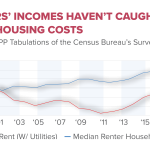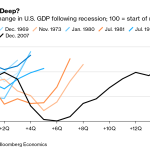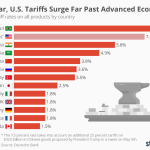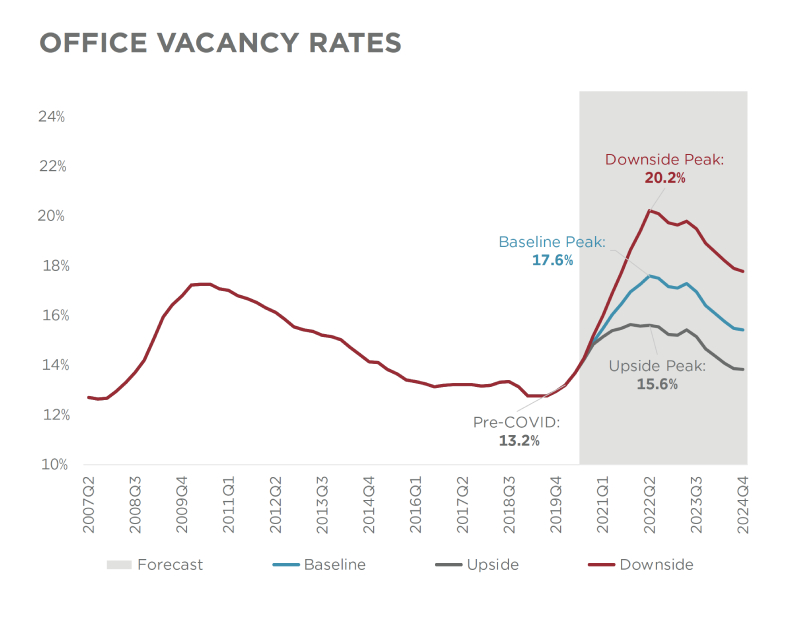Office vacancy rates have emerged as a critical indicator of the health of the commercial real estate market, particularly in the aftermath of the pandemic. As businesses continue to adapt to new working models, many office buildings remain underutilized, leading to vacancy rates soaring between 12 to 23 percent in major cities like Boston. This troubling trend not only signifies a shift in demand for office spaces but also raises questions about the economic impact of vacancies on urban economies. High vacancy rates may strain financial institutions, especially as many real estate loans are set to mature in the coming years. The connectedness of the banking sector to commercial real estate makes understanding these vacancy rates essential for anticipating potential vulnerabilities in our economic landscape.
The phenomenon of workspace availability directly correlates with shifting trends in the commercial property landscape, hinting at deeper implications for urban economies. With many corporations reconsidering their office footprint, the rise in unused spaces could lead to significant economic repercussions, particularly in certain regions. Terms such as “commercial property performance” and “real estate market fluctuations” become pivotal in discussions about the consequences of high office vacancy rates. As we delve into this topic, it’s essential to recognize how these trends can affect not just businesses but also the stability of financial institutions and their lending practices. Ultimately, the interplay between working space requirements and economic vitality cannot be overstated, affecting everything from real estate investments to the broader economy.
The Current State of Office Vacancy Rates
Office vacancy rates have become a pressing concern in major urban centers across the United States. Reports indicate that these rates have surged post-pandemic, falling between 12% and 23% in cities like Boston. This phenomenon can largely be attributed to a fundamental shift in work culture, where businesses continue to adopt hybrid and remote work models that reduce their need for physical office spaces. As a result, a staggering number of office buildings lie empty, creating an oversupply that depresses property values and stagnant rental prices.
This decline in demand for office space not only affects landlords and building owners but also has far-reaching economic implications. When large swaths of office space remain vacant, it directly impacts local businesses that rely on foot traffic, such as restaurants and retail stores. Additionally, municipalities face drops in property tax revenues, which could lead to budget shortfalls and compromised public services. Therefore, the current state of office vacancy rates doesn’t just signify a real estate issue; it signals potential economic distress that could ripple throughout local economies and beyond.
Frequently Asked Questions
How do high office vacancy rates impact the economy?
High office vacancy rates can significantly impact the economy by lowering property values, reducing tax revenues, and increasing the risk of bank failures due to delinquent commercial real estate loans. As businesses reassess their office space needs, sustained high vacancies contribute to an economic slow-down in urban areas, affecting everything from local businesses to broader market stability.
What are the economic ramifications of a surge in commercial real estate vacancies?
A surge in commercial real estate vacancies can create a ripple effect, leading to decreased consumer spending and lower lending from financial institutions. This situation can stress the banking sector by increasing vulnerability to defaults on real estate loans, which may, in turn, decrease overall economic growth and consumer confidence.
Are high office vacancy rates a sign of a larger economic crisis?
While high office vacancy rates indicate stress in the commercial real estate sector, they do not necessarily signal a larger economic crisis. The economy can remain stable despite these challenges; however, if vacancy rates continue to rise and lead to significant bank delinquencies, it could exacerbate existing vulnerabilities in the banking sector.
What factors have contributed to the rising office vacancy rates in major cities?
Rising office vacancy rates in major cities are primarily due to the shift to remote work driven by the pandemic, coupled with an oversupply of commercial real estate. Businesses have reassessed their need for physical office space, leading to prolonged vacancies and depressed property values across the commercial real estate landscape.
Is there any hope for reducing office vacancy rates in the near future?
Reducing office vacancy rates may hinge on a significant decrease in long-term interest rates, which would facilitate refinancing of existing real estate loans. However, without a dramatic shift in occupancy trends and workplace dynamics, sustained high vacancy rates may linger, impacting the commercial real estate market and the broader economy.
What role do banks play in the current high office vacancy scenario?
Banks play a critical role in the high office vacancy scenario as they often hold substantial commercial real estate loans. With a significant amount of these loans coming due, banks may face heightened risk of losses due to defaults, particularly from smaller, regional banks that were less regulated after the 2008 crisis.
Can high office vacancy rates lead to increased economic vulnerability in the banking sector?
Yes, high office vacancy rates can lead to increased economic vulnerability in the banking sector. As banks face potential delinquencies on commercial real estate loans, they may tighten lending practices, which could further depress economic activity and consumer confidence.
How do rising interest rates affect office vacancy rates and the overall real estate market?
Rising interest rates can exacerbate office vacancy rates by making financing more expensive for property owners, leading to reduced investment in maintaining or leasing space. This can decrease demand and further increase the vacancy rates, creating a challenging cycle for the overall real estate market.
What strategies can be employed to mitigate the impact of high office vacancy rates on the economy?
Mitigating the impact of high office vacancy rates involves fostering adaptive reuse of commercial properties, encouraging economic diversification, and implementing policies that stimulate job growth. Additionally, financial institutions can adopt flexible lending practices to support affected businesses and encourage occupancy in vacant spaces.
What is the long-term outlook for commercial real estate given current vacancy trends?
The long-term outlook for commercial real estate is complex, with high vacancy rates potentially persisting in the short term. However, adaptability in the commercial sector, such as converting office spaces to mixed-use developments, could ultimately lead to recovery as market demands shift. Economic resilience will depend on broader financial stability and recovery from ongoing economic challenges.
| Key Point | Details |
|---|---|
| High Vacancy Rates | Office vacancy rates in cities like Boston range from 12% to 23%, resulting in decreased property values. |
| Impact of Interest Rates | High vacancy rates combined with the Federal Reserve’s reluctance to lower interest rates pose risks for banks and financial markets. |
| Commercial Mortgage Debt | $4.7 trillion in commercial mortgage debt is due this year, with potential for substantial losses among investors. |
| Regional Banks’ Vulnerability | Smaller banks, less regulated, are at greater risk of failure due to their exposure to commercial real estate losses. |
| Economic Outlook | Despite challenges, the broader economy remains strong with a solid job market and stock performance. |
| Potential Solutions | Falling long-term interest rates could open doors for refinancing and alleviate some pressure on commercial real estate. |
Summary
Office vacancy rates are at an all-time high, posing significant challenges not only for the real estate market but also for the broader economy. As businesses continue to navigate post-pandemic work arrangements, the demand for office spaces declines, leaving many buildings underutilized. The convergence of high vacancy rates and looming commercial mortgage debt threatens financial institutions, particularly regional banks with significant exposure to real estate loans. Experts suggest that while immediate risks may not lead to a widespread economic meltdown, the situation’s slow unraveling could impact consumers indirectly through tighter lending and regional economic contractions. To mitigate these risks, a reduction in long-term interest rates could provide some relief, but the future remains uncertain.








